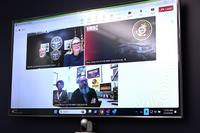There are many features of LinkedIn that I love, but the summary section is my favorite. Profile pictures show me what you look like, your banner image tells me something about your work or environment, and your headline reflects what you're doing or focused on doing.
The summary, however, tells me about you as a person. It's the place on your LinkedIn profile where you tell your story -- your career path, transition from the military, goals and results.
Think of it this way: Your headline and photo show me what you are; your summary tells me who you are and why I should care.
To make your summary stand out and get read, follow these tips:
Be Genuine and Interesting
While LinkedIn is a professional site, we're all real people looking to connect with other real people. Tell your story in your own voice and with the same level of enthusiasm, humor and focus you would if we met in person. As Julie Inouye, head of corporate communications and marketing at LinkedIn, shared, "Think of your summary as your elevator pitch; how would you spark interest in just 20 seconds? Instead of a laundry list of your work experience, concisely share your passions, motivations, goals and what makes you unique as a professional."
Use Keywords
Speak the language of the target audience you want to attract. As you transition from the military to civilian workforce, this can feel like a steep learning curve. Your job now is to speak like your target employer. If they refer to personnel professionals as "human resource specialists," use that term. If they call them "chief people officers," consider working that into your narrative.
Recruiters and hiring managers are using LinkedIn to find talent, and they are relying on the search feature. If your keywords aren't matching theirs, you won't be found.
To learn what keywords matter to these employers, scour their websites, read the job descriptions, talk to your contacts that work for the company and look for patterns. Show the employer that you already speak their language.
Show Your Personality
If you're funny, add humor to your summary. If you're not, this isn't the place to try it out. If you -- like me -- are a high-energy, passionate and strong personality, it's OK to let that out. The first part of my LinkedIn summary is bold, energetic and ends with an exclamation point! Why? Because if you and I talk, you'll soon see that's the real me. I talk in exclamation points!
The risk, you might worry, is that if you are genuine and show your personality, someone might be turned off or disregard you. Yes, that is true. Ask yourself whether you'd want to work with them if they won't appreciate your genuine personality.
Summarize Your Results
Weave in your career history and results. Use bulleted lists in your summary if the paragraph gets too long. People like lists and short paragraphs, particularly online (or when viewing your summary section on a mobile device). Don't repeat the lists verbatim in your experience section, but include them here if they round out your story of who you are and why you matter.
Tell the Reader What You're Looking For
Excited to connect with like-minded professionals? Say that. Looking to join a startup in the aerospace industry, particularly in the Seattle area? Put that down. Viewers appreciate direction and like to know what you need.
The reader may only read the first few sentences or even paragraphs of your LinkedIn summary, so draw them in. Show them who you are and why they should care. Your profile has a tremendous amount of potential, and the summary is the front door to all those valuable connections.
Want to Know More About Veteran Jobs?
Be sure to get the latest news about post-military careers as well as critical info about veteran jobs and all the benefits of service. Subscribe to Military.com and receive customized updates delivered straight to your inbox.












